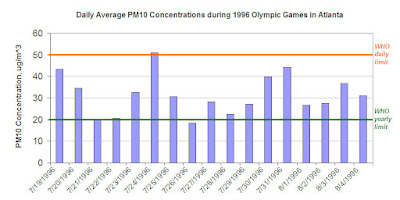 This is the first of what I hope will be several posts over the course of this week exploring historical air quality data from other Olympic cities. I'm starting with Atlanta because that's where I grew up. :)
This is the first of what I hope will be several posts over the course of this week exploring historical air quality data from other Olympic cities. I'm starting with Atlanta because that's where I grew up. :)Summary: Since the car ban went into effect in Beijing on 7/20, the average concentration of PM10 in Beijing's air has been 3.4 times higher than that in Atlanta during the 1996 Olympic Games. During the 1996 Olympics, the overall average concentration of PM10 in Atlanta was 31 ug/m^3. The highest daily average concentration was 51 ug/m^3. These values correspond to a Chinese API of 31 and 51, respectively. Since the car ban went into effect in Beijing on 7/20, Beijing's overall average concentration of PM10 has been 104 ug/m^3, with a daily average high of 186 ug/m^3. These values correspond to a Chinese API of 75 and 118, respectively.
Analysis: To start with, let's examine data sources. The most complete data source I found for historical air quality data in Atlanta was Georgia's Ambient Monitoring Program Database Query for Pollutant Data.
Historical data available for the Atlanta metro area during the Olympic period (7/19/96-8/4/96) includes ozone, SO2, CO, and PM10. (Info on available data is here; for this analysis I looked at the Georgia Tech monitoring station).
Ideally, we would compare all four pollutants to Beijing's current levels. However, since we have no ozone data for Beijing, and PM10 is almost always the highest reported pollutant in Beijing, I focused my analysis for now only on PM10. Depending on time and interest, I may ultimately try to run numbers for CO and SO2, but we'll see.
I queried the Georgia database for PM10 data for various time frames and averaged the results to generate the following table:
 (Maxes and mins are from daily averages, not hourly data points.)
(Maxes and mins are from daily averages, not hourly data points.)(For a description of how to convert PM concentration to Chinese API, see the bottom of this post.)
From this table we can observe the following:
1) During the 1996 Olympics, the overall average concentration of PM10 in Atlanta was 31 ug/m^3. The highest daily concentration was 51 ug/m^3. These values correspond to a Chinese API of 31 and 51, respectively.
2) Atlanta's PM10 concentrations one month before the Olympics were significantly higher than they were during the Games.
3) Atlanta's PM10 concentrations exactly one year after the Olympics were not significantly different than they were during the Games.
The following graph shows the daily average PM10 concentrations for Atlanta during the 17 days of the Olympics:

Now let's compare to Beijing.
First of all, Beijing's 2007 average PM10 concentration was 148 ug/m^3, nearly 5 times Atlanta's average during the 1996 Olympics. (Source: Beijing 2007 Environmental Yearbook, in Chinese).
Since the car ban went into effect on 7/20, I calculate an average PM10 concentration for Beijing of 104 ug/m^3. This is significantly lower than the 2007 average, and is within Beijing's own air quality goal of a PM10 concentration below 150 ug/m^3 (corresponding to an API of 100), but is still about 3.4 times higher than the average concentration in Atlanta during the 1996 Games.
But during the Olympics, we care less about averages, and more about the precise daily results during a specific 17-day period. Since 7/20, Beijing has had a number of days which exceed China's air quality standard, the highest being 7/26, with an average daily PM10 concentration of 186 ug/m^3 (corresponding to an API of 118).
(Source for all Beijing API data is the query function at the bottom of MEP's API page (in Chinese).)
Conclusion: It seems clear that, at least from the perspective of PM10 concentration, Beijing's average air at present is still significantly more polluted than the air was in Atlanta during the 1996 Olympic Games. If Beijing hopes to equal Atlanta's air quality with respect to PM10, Beijing's API during the Games should average 31 or below.




2 comments:
Great post. I'm wondering more about Beijing vs Los Angeles or even Beijing vs Athens.
Chaise Lounge: "Beijing was Great!
Post a Comment
Note: Only a member of this blog may post a comment.